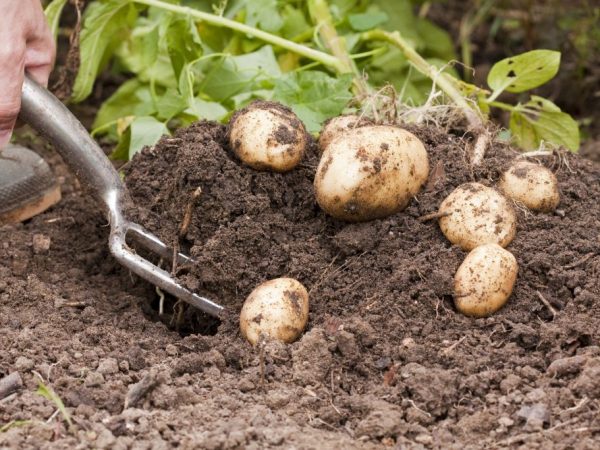Characteristics of the Leader potato variety
Among the majority of table-industrial potato varieties, the early-maturing Leader potato deserves special attention. This variety became famous for its productivity and unpretentious care.

Description of the potato variety Leader
Advantages of the variety
The Leader variety quickly gained popularity among gardeners and farmers, due to the large number of advantages that distinguish it favorably against the background of most table varieties:
- The versatility of tubers. Due to the high starch content in fruits (up to 12.2%), these potatoes are used both for table needs and for industrial use. Starch, chips, dry potato mixes, etc. are prepared from Leader's tubers. When cooked, it can be a filling for dumplings and pies, suitable for frying and mashed potatoes.
- High productivity from one bush. With proper care and sufficient watering, 8 to 12 large tubers are harvested.
- Transportability and keeping quality of tubers. Thanks to their strong skin, these potatoes can be stored for a long time without losing their qualities. During transportation, the tubers are not damaged, which allows the crop to be transported over long distances without the risk of losing part of the load.
- Disease resistance. This type of tuberous is resistant to most diseases: late blight, dry rot, black leg, rhizoctonia, spotting.
Disadvantages of the variety
But, despite the fact that the Leader variety has such a large set of advantages, some negative characteristics are also present in it:
- Pests. The variety does not have resistance against the Colorado potato beetle, which means that it requires timely treatment of bushes from pests. The tubers are also affected by the nematode, bear and wireworm.
- Irrigation. The leader can grow in a wide variety of regions, but in an area of too arid climate, bushes require irrigation and soil moisture. Lack of moisture negatively affects the level of yield, as well as the size of the tubers.
- Hilling. The variety is unpretentious in care, but still requires high-quality hilling. It is especially important to carry out this procedure if the crop grows in field soil conditions.
Landing

Delicious potatoes
Its yield directly depends on compliance with the planting rules of this variety. The variety is planted in the first half of April. To ensure a high percentage of germination of the culture, the tubers are prepared for planting.
Sprouting tubers
According to the description, germination of tubers begins no later than 30-35 days before the date of planting. Tubers for planting are selected, guided by the following principle: medium size, a large number of active eyes, healthy fruits without damage.
Wooden boxes lined with polyethylene are best for sprouting tubers. The fruits are laid neatly, avoiding strong compaction.
It is also important to observe the temperature regime for germination. Temperatures between 14 ° C and 16 ° C are ideal.
Preparing the soil for planting
The leader is an undemanding variety; in soils of different density, it gives different yield indicators. So in dense soils, it is better to plant tubers in shallow pits, not forgetting that on the surface the soil loses moisture faster, which means that you will need to irrigate the bushes and moisten the soil more often. If the soil is light and fluffy, the seed is planted to a depth of 15 cm to 20 cm. This depth provides the tubers with the maximum amount of moisture even without irrigation.
Variety care
According to the description, this type of tuberous does not require special care as it can grow in almost any soil. But this is not a reason to completely abandon irrigation or fertilization of the soil.
Watering
The frequency and abundance of soil moisture and irrigation of the bushes depends on the climate to which this type of tuberous grows. So in regions with hot dry summers it is worth watering the bushes once a week. In temperate climates, it is sufficient to moisten the soil once a month. In humid climates, the soil does not need to be moistened.
Weeding
Weeding a crop directly depends on the quality of the soil. If these are field soils, weed germination will be more intense here. This means that weeding is required much more often.
To simplify the task will help pre-treatment of soils with weed control preparations. The main thing is to remember that even after processing the soil will require care, but the planting will overgrow less intensively, which will greatly facilitate the care of the variety.
Fertilizer
The leader, unlike other potato varieties, grows well even without fertilization. But if the soil is too clayey or depleted, you will have to feed the bushes.
First feeding
The first feeding is carried out when the potatoes gave the first shoots and leaves appeared on the bushes. Organic fertilizer is best suited for the first feeding. You can use mullein or poultry manure solution.
Second feeding
The second time, fertilizer is applied during the flowering period of the bushes. For feeding, a solution of ash and urea is used.
Third feeding
The third time fertilization is applied 2 weeks before harvest. For this, artificial drugs and mixtures are used.


